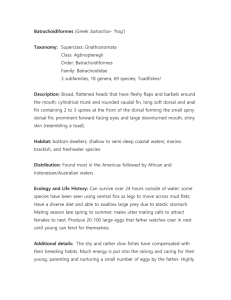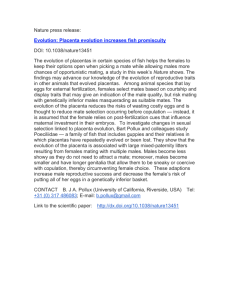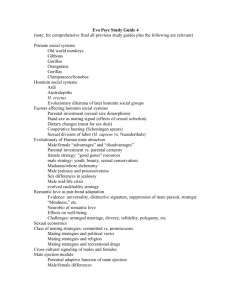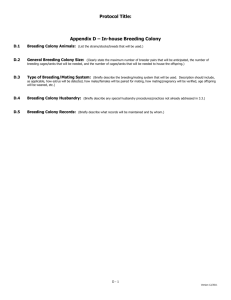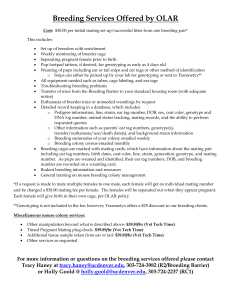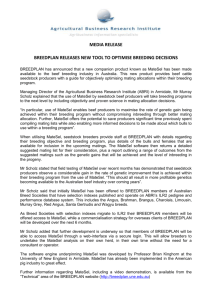File - Year 5/6 Class Page
advertisement
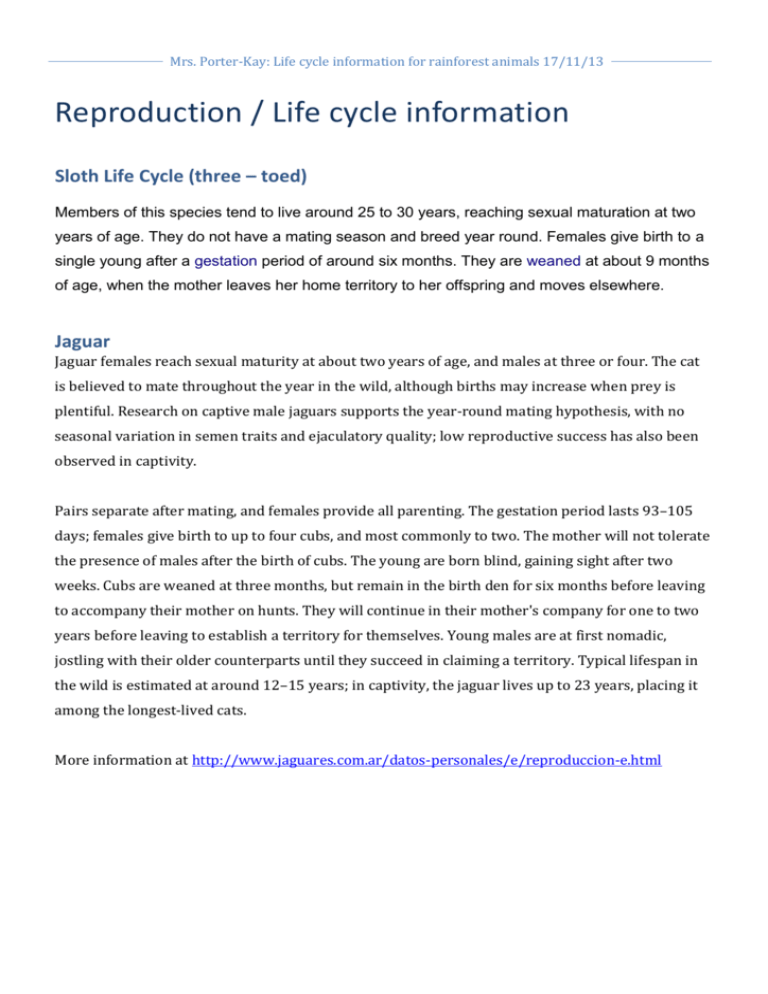
Mrs. Porter-Kay: Life cycle information for rainforest animals 17/11/13 Reproduction / Life cycle information Sloth Life Cycle (three – toed) Members of this species tend to live around 25 to 30 years, reaching sexual maturation at two years of age. They do not have a mating season and breed year round. Females give birth to a single young after a gestation period of around six months. They are weaned at about 9 months of age, when the mother leaves her home territory to her offspring and moves elsewhere. Jaguar Jaguar females reach sexual maturity at about two years of age, and males at three or four. The cat is believed to mate throughout the year in the wild, although births may increase when prey is plentiful. Research on captive male jaguars supports the year-round mating hypothesis, with no seasonal variation in semen traits and ejaculatory quality; low reproductive success has also been observed in captivity. Pairs separate after mating, and females provide all parenting. The gestation period lasts 93–105 days; females give birth to up to four cubs, and most commonly to two. The mother will not tolerate the presence of males after the birth of cubs. The young are born blind, gaining sight after two weeks. Cubs are weaned at three months, but remain in the birth den for six months before leaving to accompany their mother on hunts. They will continue in their mother's company for one to two years before leaving to establish a territory for themselves. Young males are at first nomadic, jostling with their older counterparts until they succeed in claiming a territory. Typical lifespan in the wild is estimated at around 12–15 years; in captivity, the jaguar lives up to 23 years, placing it among the longest-lived cats. More information at http://www.jaguares.com.ar/datos-personales/e/reproduccion-e.html Mrs. Porter-Kay: Life cycle information for rainforest animals 17/11/13 Toucan Mating System: monogamous The breeding season for toucans occurs in the spring. Tree cavities are the typical nesting site where a single clutch of 2 to 4 eggs are laid by the female. Toucans breed yearly. The hatchlings are bare-skinned, close-eyed, and helpless until approximately 6 to 8 weeks later. At this time, the young begin to develop their characteristic beak and will soon fledge. Toucans become sexually mature in 3 to 4 years. Breeding interval: Toucans breed once yearly. Breeding season: The breeding season occurs in the spring. Range eggs per season: 2 to 4. Range time to hatching: 15 to 18 days. Range fledging age: 6 to 8 weeks. Range age at sexual or reproductive maturity (female): 3 to 4 years. Range age at sexual or reproductive maturity (male): 3 to 4 years. Key Reproductive Features: seasonal breeding. Both parents take turns incubating the eggs in the small cavity of a tree where the nest is situated. The young remain in the nest for about 6 to 8 weeks. Mandrill The Mandrill becomes mature at about 3 ½ years of age. The females will initiate mating if she is interested in him. It takes about 5 months from conception for the young to be born. There is no set mating season for these Monkeys. The mothers are very excited to have the young arrive. They take very good care of them and won’t mate again until the young they have to care for are mature. If a baby should die then they will mate again in the hopes of being able to replace it. Mandrill fact sheet useful for your information report http://www.denverzoo.org/downloads/dzoo_mandrill.pdf Mrs. Porter-Kay: Life cycle information for rainforest animals 17/11/13 Lemur For most species of Lemurs the mating season is very short. This is usually less than three weeks per year. The time of year for mating of the Lemurs is environmentally effected. That means that in some areas the young are born during the winter months. Yet there is very warm weather there annually. In other areas though the young are born in the spring or the summer. The incubation periods will also very. It can be as low as 9 weeks in some species. For others though it can be up to 24 weeks. Studies show that the smaller the size of the Lemur the more young that will be born at once. The smaller species will average 2 at a time but can have up to 4. The larger species typically have 1 offspring at a time but can have 2. The availability of food often determines when Lemurs will reproduce. When food supplies are short they will avoid breeding. This is a natural method for them to be able to continue to increase their own chances of survival. The babies are very vulnerable at birth. The mothers will carry them around in her mouth until they are able to hold on her back safely. They will continue to piggy back on here until they are old enough to move through the trees on their own. They stay with their mothers for 2 years before venturing out on their own. Baby Lemurs consume milk from their mothers until they are old enough to forge on their own. The emerging of the first molar is when the mother will stop feeding them from her body. What is very interesting is that the weaning period for these young Lemurs is often timed right around the time of year when the food is the most plentiful. The mortality rate is very high for baby Lemurs. More than half of them will die before they are able to leave their mom and go out on their own. The typical life span of a Lemur in the wild is approximately 18 years. Tree Kangaroo Information including reproduction http://www.tree-kangaroo.net/tkInfo.html Mrs. Porter-Kay: Life cycle information for rainforest animals 17/11/13 Orangutan Orangutan Breeding and Reproduction Orangutan males are ready to mate when they are approximately 15 years of age. For girls it is about 12 years of age. For these apes, they live along instead of in groups. When it is time for mating though the males and females find each other through a variety of calls as well as the scents that their bodies offer from various glands. The males also make what are called long calls followed by bellows. They can be heard for a very long distance. They are often used to call in females that are mature and ready for mating. These calls can go on for hours and hours when a mature male is determined to find a female that he can mate with. He will even pass up eating in order to continue his calls. As a male gets older he will grow larger flaps on his cheeks. These flaps are a physical attraction for the females. This is one of the reasons why it is the older male orangutans that generally get to engage in mating with the mature females. Generally these older males are also strong enough to fight off the younger ones that do want to challenge their territory. Males can be extremely aggressive when it comes to mating. They will force females to mate if they won’t do so willingly. If the female is strong enough she may be able to get away from the male. However, usually she won’t be strong enough and has to endure the process whether she is interested or not. If the mating is consensual then the pair may spend several days together interacting and mating before they go their separate ways again. After mating takes place, it takes from 8 ½ to 9 months for the baby to be born. There is almost always one baby born. There are few known cases of twins being born in captivity so it is assumed that this is not common in the wild. A newborn is about 3 1/2 pounds. The females take very good care of their offspring. It is common for the young to stay with their mothers for about the first 7 years of life. Most of the information we have about social behavior of orangutans in the wild is based on these types of interactions. For the first couple of years of life the babies ride on the backs of their mothers. Once they are old enough to consume fruits they will follow her through the forest. The childhood of the orangutan is the longest of all apes. It is also one of the longest of all animals out there. As a child becomes old enough to leave the mother, he or she will start to feed further and further away. Then one day the two will simply part ways and then she will be willing to mate again. Mrs. Porter-Kay: Life cycle information for rainforest animals 17/11/13 Should a mother orangutan lose her baby early on, she will be ready to mate much sooner. There are reports of mature males trying to kill the offspring in an effort to get the female to reproduce with him. However, these females can be very defensive when it comes to protecting their young. Hornbill Hornbills generally form monogamous pairs, although some species engage in cooperative breeding. The female lays up to six white eggs in existing holes or crevices, either in trees or rocks. The cavities are usually natural, but some species may nest in the abandoned nests of woodpeckers and barbets. Nesting sites may be used in consecutive breeding seasons, by the same pair. Before incubation, the females of all Bucerotinae—sometimes assisted by the male—begin to close the entrance to the nest cavity with a wall made of mud, droppings and fruit pulp. When the female is ready to lay her eggs, the entrance is just large enough for her to enter the nest, and after she has done so, the remaining opening is also all but sealed shut. There is only one narrow aperture, big enough for the male to transfer food to the mother and eventually the chicks. The function of this behaviour is apparently related to protecting the nesting site from rival hornbills. The sealing can be done in just a few hours, at most it takes a few days. Having sealed the nest it takes a further five days for the first egg to be laid. Clutch size varies from one or two eggs in the larger species to up to eight eggs for the smaller species. During the incubation period the female undergoes a complete and simultaneous moult. It has been suggested that the darkness of the cavity triggers a hormone involved in moulting. When the chicks and the female are too big to fit in the nest, the mother breaks out, then both parents feed the chicks. In some species the mother rebuilds the wall, whereas in others the chicks themselves rebuild the wall unaided. The groundhornbills are conventional cavity-nesters instead. Mrs. Porter-Kay: Life cycle information for rainforest animals 17/11/13

